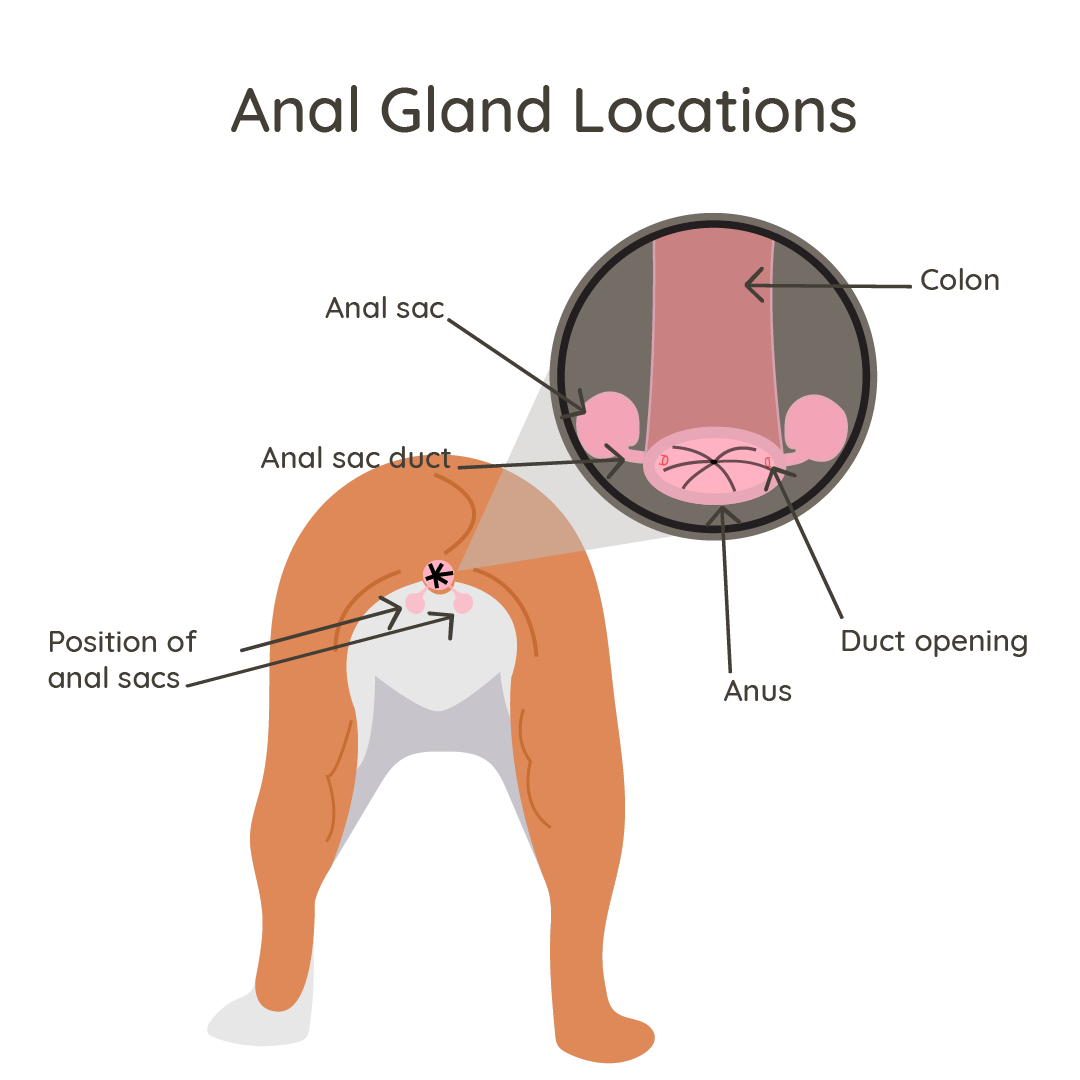Anal Gland Issues
Anal glands are two small scent glands used for marking, and are located just at the inside of the anus at around 4 and 8 o’clock. Dogs, cats, and many other mammals have these glands. These fluid-filled sacs contain a very pungent fishy-smelling secretion that can vary in consistency from watery to thick and pasty. Under normal circumstances in most pets, self-grooming, defecation and exercise facilitate the automatic emptying of these glands. Many dogs and cats will also involuntarily express their anal sacks when they are fearful or stressed. When the anal glands are not emptied and become overly full (often referred to as “impaction”), they can become painful, inflamed, infected, or even abscessed. The good news is that most pets will go through life with no anal gland issues, but you should be aware of the signs and treatments.

Highlights
- Both cats and dogs can develop anal gland issues, but the problem is much more common in dogs, particularly small dogs and specific breeds.
- Risk factors that increase the likelihood of your pet having anal gland issues include:
- Obesity
- Difficulty reaching and self-grooming the rear end, often due to old age
- Chronic skin issues
- Insufficient fiber in the diet
- Chronically softer than normal stool
- Food and/or environmental allergies
- High risk dog breed:
- Toy and miniature breeds such as poodles, Chihuahuas, and Yorkshire terriers
- Lhasa apsos
- Cocker spaniels
- Basset hounds
- Beagles
- Brachycephalic breeds such as bulldogs and French bulldogs
- Anal gland issues can be indicated by these symptoms. Signs are similar for both dogs and cats, but can be much more subtle in cats.
- Excessive licking or itching the anal area.
- Scooting the rear end along the floor.
- Excessive biting at the base of the tail.
- Carrying the tail down.
- The rear end seems painful or sensitive to touch.
- Straining or painful defecation.
- Blood and/or pus in the stool, or near the rectum.
- Presence of a matted, crusty area on one side of the anus.
- Abnormal swelling, often painful, on one side of the anus.
- If your pet is displaying any signs of an anal gland problem, consult with your veterinarian. After examining your pet and ruling out other causes, your veterinarian may manually express the sacs. Antibiotics may also be prescribed. Soemtimes, the anal glands will also need to be infused with medicine.
- An infection in the anal glands can become severe enough that abscesses develop. Treatment might require surgical intervention under heavy sedation or anesthesia.
- Most chronic anal gland issues can be managed by treating the underlying predisposing conditions, plus regular manual expression.
- In the small percentage of chronic cases which cannot be effectively managed, the anal glands may be surgically removed. This procedure is very effective in solving the problem but also involves a small risk of significant complications. Your veterinarian can help you decide if surgery is the right choice for your pet.
Tips
- While difficult to spot, the opening to the glands can be seen at the 4 and 8 o’clock position around the anus. The actual glands are not visible and can only be felt during a rectal manipulation by an experienced individual.
- While anal gland issues are much more common in smaller and medium-size dogs, don't rule it out as a possible cause of rear-end discomfort in any dog or cat.
- If you notice your pet exhibiting even subtle symptoms that might be related to the anal glands, don’t ignore it! If treated early, the issue can usually be resolved simply and inexpensively. Delayed care will often lead to your pet being unnecessarily uncomfortable, as well as more involved and expensive treatment.
- For pets that are prone to anal gland issues, a preventative strategy is a must. Your veterinarian can help you establish a routine anal gland expression schedule and possibly nutritional changes that will help effectively manage this condition.
- Anal sac expression can be done either externally or internally. Most groomers do it externally, while most veterinary professionals do it internally. In general, internal expression is much more effective, but requires experience.
- Expressing the anal glands is an unsavory procedure, but most pet parents can learn how to do this task if desired. If you are the type of person who wants to do it yourself, make sure a veterinary professional teaches you the procedure. This is especially important for the internal expression method. Trauma and significant medical complications can be caused by careless expression.
- The average pet that is not exhibiting signs of anal sac irritation does not need manual expression. By far, most pets do not need any help regulating their anal glands.
- While scooting is often related to anal gland discomfort, this is not always the case. Look around the anus and on the stool for any evidence of internal parasites, especially tapeworms.
- The discomfort caused by fleas can mimic anal glands issues, as fleas are often found around the base of the tail.